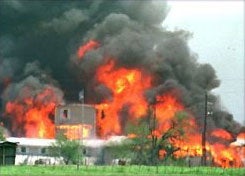The History of CIAG
In February 1993, the Bureau of Alcohol, Tobacco, Firearms and Explosives attempted to execute a search warrant of the Mount Carmel Center, the center of operations for the Branch Davidians religious sect. ATF believed that the Branch Davidians were stockpiling firearms and other weaponry in the Center and planned to execute a surprise raid. The raid failed and the resulting shootout between federal agents and members of the Branch Davidians cost the lives of four agents and six Branch Davidian members. Following this shootout, the FBI laid the Mount Carmel Center under siege while attempting to negotiate the surrender of the Center and the release of the children therein. After 51 days of siege, the FBI attempted to use noxious gas to drive people out of the Center. The Center caught fire and many members of the Branch Davidians lost their lives.
The resulting judicial and Congressional investigation highlighted the need for expert consultation in the FBI’s response to certain critical incidents. Dr. Gregory Saathoff, a forensic psychiatrist and professor at the University of Virginia School of Medicine, was tapped to serve as the liaison between the FBI and experts from academia and the private sector. He founded the Critical Incident Analysis Group in the University of Virgina’s Emergency Medicine department. This group, CIAG, has organized and hosted yearly conferences between complementary groups of academic, media, government, military, and law enforcement professionals with the aim of analyzing and assessing critical incidents and establishing creative links between specialists and agencies.
CIAG faculty members conduct research independently as well and have published extensively on diverse sub-fields of critical incident analysis ranging from forensic psychiatry to toxicology. For a list of publications, click here. For a list of
 On April 19, 1993 the FBI raided the compound of the Branch Davidians in Waco, Texas. The raid ended a fifty-one day standoff, but not without significant loss of life and subsequent Congressional and judicial investigation.
On April 19, 1993 the FBI raided the compound of the Branch Davidians in Waco, Texas. The raid ended a fifty-one day standoff, but not without significant loss of life and subsequent Congressional and judicial investigation.
One group that looked at the Waco incident was a small university organization at Michigan State University called the Critical Incident Analysis Group.
During this same time period in the mid-1990’s, Dr. Greg Saathoff of the University of Virginia was asked to serve on a commission organized by the U.S. Attorney General. The commission was asked to develop a process by which the Federal government might better access outside resources in the private sector during national crisis. It proposed the creation of an outside Conflict Resolution Specialist position. The specialist would act as a liaison between the FBI’s Critical Incident Response Group (CIRG) and outside experts. Because of his background and experience in crisis consultation with the Federal government, Dr. Saathoff was asked to serve as the specialist, and accepted that position.
Soon after accepting the liaison position, Dr. Saathoff was contacted by the Michigan State group. It was clear there was a common purpose between the group and the newly created FBI position. As a result, the Critical Incident Analysis Group (CIAG) was brought to the University of Virginia. Dr. Saathoff took on the role as the Executive Director for CIAG. With the aide of seasoned experts in academe, the private sector and government, a multidisciplinary group was assembled.
Since the first conference in 1998, CIAG’s annual conference in Charlottesville, VA has assembled a complementary group of academic, media, government, military, law enforcement, and behavioral science professionals. This is done in an effort to establish creative links between specialists and agencies. Although both the executive director and chair both serve on the faculty of the University of Virginia, the CIAG’s leadership represents faculty from a number of international and national universities. The design of the CIAG’s governing structure recognizes the emphasis that Jefferson placed on international and multidisciplinary perspectives.
Since arriving at the University of Virginia, CIAG has utilized case studies as springboards for discussion. At the conferences, the group has chosen to study such issues as communicating in crisis and strategies for dealing with terrorist hostage taking. At all times, the group attempts to merge theory with practice. Because of the issues the group discusses, CIAG has played a key role in understanding and responding to the challenges of homeland security and terrorism.
CIAG has had an important role in convening multidisciplinary conferences relating to national security threats. Biothreat and Bioterror have received focus through the work of the Critical Incident Analysis Group. In 2008, and in response to the Amerithrax Investigation of the anthrax mail attacks, Dr. Saathoff was appointed by Chief Federal Judge Royce Lamberth to chair the Expert Behavioral Analysis Panel. In addition to faculty from the University of Virginia’s School of Medicine, Panel members included faculty from Harvard Medical School, Johns Hopkins, the University of North Carolina, Duke University, The Uniformed Services University of Health Sciences, Rochester University and leadership from the American Red Cross. Their work resulted in the Expert Behavioral Analysis Panel Report.
